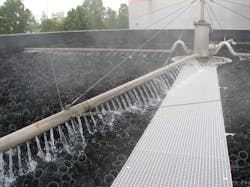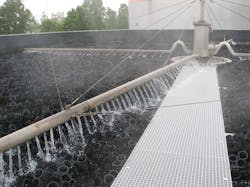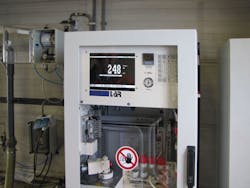Wastewater from paper production is known to be challenging to treat. One paper mill in the Netherlands required a new TOC analyser to monitor the concentration of the inlet water stream to its biofilters. Piet Broertjes explains how a solution was found that helped ensure a higher degree of treatment efficiency and purity of discharged effluent into the North Sea Canal.
Paper mills are known for their substantial use of production water. Wastewater generated from these mills is known for its problematic composition and characteristics. The percentage of bio-based materials is relatively low and, as a consequence, the purification of it is tough.
Essentially the wastewater contains minuscule fibres, fillers, whiteners, carbonates, starch, pigments, glues and additives, etc. These elements are present as particulates (suspended solids) as well as in a dissolved state.
Paper production in the Netherlands
Crown Van Gelder N.V. (CVG) is an independent, modern paper manufacturer. The paper mill is located on the North Sea Canal close to Amsterdam/ Velsen in the Netherlands. CVG produces specialties for graphical and industrial applications in the wood free uncoated and single-coated paper sector. The annual production capacity of the two sophisticated paper machines approaches 220,000 tons of paper on reels.
At CVG most of its production water is reused in the process, partly treated by their two-stages wastewater treatment plant. Firstly, through a physical-chemical purification and then by biological purification in two biofilters.
Generally online analysers and paper mill wastewater don't go well together. The wastewater has the annoying tendency to foul and plug/block the wetted parts e.g. sample tubes, sample pump, solenoids, vessels, reactor etc.
The time investment that is needed to clean and replace the relative small analyser parts is just too long. It is therefore very understandable that paper mill maintenance and service engineers shy away from using on-line analysers.
CVG started with a Total Organic Carbon (TOC) analyser market study. The selection criteria they where demanding included accurate measuring results, reliable operation, fast response, low use of reagents, multi stream capabilities, rugged, low maintenance and of coarse a reasonable investment. To be safe CVG engineers wanted to visit a reference installation, have test samples being analysed and carry out a two month trial on site.
Peak shaving
In March 2012 a new online TOC analyser was installed - the LAR QuickTOC - to monitor the concentration of the inlet water stream to the biofilters. Composite samples where collected and analysed by their laboratory by the Chemical Oxygen Demand (COD) analysis method, proving that the online TOC method correlates very well to the COD method.
The degradation of solved organic substances, mainly partially degraded starch, is done by a layer of microbial organisms that grow on the hollow filling of the biofilters.
The "healthy biological growth" of the bacteria in the biofilters can be optimised by a well balanced nutrient dosing rate. The performance and efficiency of the biofilters then improves significant.
Now, having the continuously TOC/COD input, CVG operators can match and fine tune the nutrient dosing rate even when the discharged organic load and flow of the wastewater changes. Moreover, peak loads can be avoided by pumping the highly contaminated waster into a holding and buffer tank (so called: peak shaving).
The installation of this new TOC analyser helped CVG to control its discharged waste water purity up to a quality level higher than that required by the discharge permit. Only then they return their purified water to the North Sea Canal.
Pre-testing the technology
ODS proposed to perform a durability test with real CVG samples. As the results of it were required in a relatively short period of time the procedure was speeded up.
A 10 litre tank containing CVG's wastewater was acidified to pH 2, carbonates were removed by purging the sample with carrier gas. The analyser was configured as a TC mode which offers the shortest cycle time. By use of an extra pump the sample was circulating from the tank through the analyser sample vessel back into the tank.
During a period of three weeks a relatively large amount of samples, ten times more than usual, was injected into the reactor of the TOC analyser. Every week the reactor was visually inspected.
It was proved that - even after injected more than ten thousand samples - the reactor was completely unblocked. Based on these results it was expected that the reactor maintenance would be needed only once per six to 12 months. Even then, the eventually formed residue in the reactor outlet can be removed during the analyser operation.
On-site trial
Soon the QuickTOC analyser was put online. Wastewater was pumped and transferred through a 1½" fast sample loop. Close to the analyser it flows at high velocity through the FlowSampler which is based on the so called anti-isokinetic principle.
Via a 45-degree pipe connection the sample extraction tube is brought into the centre of the fast sample loop, pointing downstream. As a result of the high velocity in the fast sample loop, big and high mass particles will pass by.
However, smaller particles, especially the saturated organic particles such as fibres and fillers, will be sucked into the sample tube and transferred to the TOC analyser. It works in a straightforward way and its operation is maintenance free. The analyser was calibrated successfully.
TOC/COD correlation study
For wastewater processing and control it is important to know the amount of oxygen that is needed to oxidise it. It can be measured by use of the laboratory COD dichromate method.
However, this COD method uses hazardous chemicals and it takes about two hours to perform a complete COD measurement.
More and more, it is replaced by the somewhat faster and easier COD cuvette test. However, both COD methods are time consuming and not suitable for online use.
On the other hand the QuickTOC analyser responds fast and is therefore very suitable for wastewater process control. The downside is that the TOC method actually is a carbon counting method instead of an oxygen demand method. Given that a good reproducible COD/TOC correlation could be found, the TOC method would be very suitable.
Therefore, CVG started a correlation study. Composite samples were taken and COD analyses were performed in the laboratory.
After a period of about a month the outcome of the COD laboratory analyses were compared to the measured TOC values. A reproducible COD/TOC correlation factor was found.
Moreover, when measuring the wastewater flow as well, the discharge load can easily be calculated by use of the following formula: Load (kg – O2/minute) = flow (litres/minute) times COD (mg/litre – O2 . 106).
Then, the wastewater's COD value and the discharge load is continuously available to be used for real time process control. This all is most useful for CVG to optimally operate their wastewater treatment plant. In those cases where the wastewater composition keeps steady and where the COD/TOC correlation factor can be reproduced, the TOC method is very suitable. Moreover, the LAR QuickTOC offers the capability to enter the COD/TOC correlation factor and its output is directly presented in mg/litre oxygen demand (COD).
Sample transfer and blow back
One point of particular interest is worth noting. During the transfer of the sample from the sampling point to the analyser inlet, the sample tube fouled by deposition of a slimy matter. It caused plugging of the sample tube. Being an exceptional case it needed an extra solution.
Hence, ODS designed, built and installed a simple blow back unit. It operated as follows: once per 50 measurement cycles a solenoid valve is activated for only a few seconds and as a consequence pressurised air flows in reverse through the sample tube. By that, all contaminates and debris is flushed back into the fast sample loop. This blow back unit proved to be very effective. From then on, the routine maintenance and attention for the analyser was reduced to a minimum.
Experience: The Best Teacher
The analyser provided Crown van Gelder with the needed information of TOC content and, through correlation, the chemical oxygen demand.
When a high peak load is monitored the operators can consider to pump this highly contaminated charge/batch into the buffer tank and postpone its gradual discharge to the biofilters to a later time. By doing so, the intake load of the biofilters is averaged.
Secondly, dosing of nutrient agents can be controlled in a smoother way. This all benefits to the health of the biofilters bacteria assuring a higher degree of treatment efficiency and, of course, to the purity of the effluent water which is to be discharged into the North Sea Canal.
Piet Broertjes is a manager of specialist environmental projects at ODS Sampling and Analytical Systems in the Netherlands.






